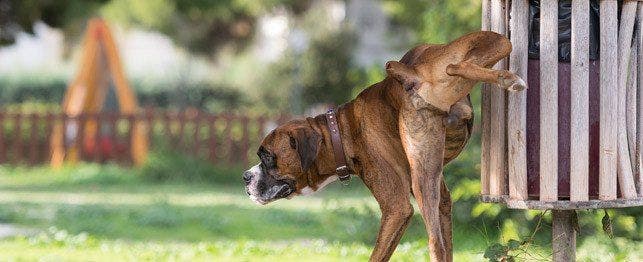
Canine Scent Marking: What’s An Owner To Do About Urine Marking?
While there is much experts do not yet know about the intricacies of canine urine marking, they do have a pretty good idea of why it happens—and how to manage it. Primarily, dogs who mark are “branding” or “staking their claim” to what they believe is their territory. When dogs hikes up their leg on a tree or fence… or even your shoes or purse, the dog is saying, “This is mine.” It’s the same behavior that compels many dogs to sprinkle their urine all around their yard or up and down the neighborhood.
Dogs don’t “mark” out of spite. They don’t think, “My mom left me home today, so I think I’ll pee on the furniture AND her new purse!” Dogs urine mark both indoors and outdoors for two primary reasons: to define and redefine territory or secondary to anxiety issues, according to Alice Moon-Fanelli, Ph.D., certified applied animal behaviorist at Animal Behavior Consultations. Territorial marking and anxiety, however, are not necessarily mutually exclusive.
Anxiety related issues can include:
- Separation anxiety
- A new pet in the household
- Conflicts with other pets or people in the household
- A new baby, boyfriend, girlfriend, spouse, relative, etc., living in the house
- The departure of a baby, friend, relative, etc., from the house
- An unfamiliar dog urinating in your dog’s yard
- New objects, such as luggage or furniture, in the house that have unfamiliar smells or another animal’s scent
Dogs who urine mark may do so in a variety of situations, such as while on walks in the neighborhood or at dog parks. Some dogs, although not all, mark both in their own home and outdoors. Some male dogs mark only when in the presence of female dogs—especially if they’re in heat—as a way of impressing a female. Some females mark as a form of competition. Some male dogs mark only when interacting with other male dogs—usually rival males. Many dogs never mark in their own home but will mark while at unfamiliar places, such as the veterinary clinic or while visiting a friend or family member’s home. That one’s embarrassing, I know. It happened to me. My 5-year-old intact show dog hiked up his leg on a friend’s Christmas tree.
Urine Marking is Not House-Soiling
House soiling or submissive/excitement urination and urine marking are completely different behaviors. If your dog is having potty accidents in the house, there are a few reasons why this might be happening:
- He’s not house trained (despite your best intentions).
- He has a medical issue, such as incontinence (some medications can cause frequent urination).
If you’re not sure what’s going on, consider these pointers:
- House-soiling generally includes a good deal of urine.
- House-soiling may occur in corners or areas you’re less likely to notice.
- Submissive or excitement urination generally occurs during greetings, physical contact, scolding or punishment.
- Urine marking generally involves small amounts of urine.
- Urine marking usually involves dogs hiking their leg on vertical surfaces, such as walls or furniture.
- Marking normally occurs in prominent locations.
What’s An Owner To Do?
Urine marking is a normal form of communication among dogs, and they can gather a lot of information by sniffing another dog’s pee. Therefore, it’s important you not correct or scold your dog. He’s not a hooligan or first-class criminal. Besides, this rarely works—even when he’s caught in the act. Also, allow your dog some access to marking while outside in his yard or during walks. By preventing him from marking all together, you may frustrate him and actually exacerbate the situation.
While outdoor marking is usually not a problem for owners—indoor marking can be a deal breaker for the human-canine relationship. To discourage additional heinous crimes against your personal property, experts recommend a proactive approach with the following strategies:
- Spay or neuter your dog. This will decrease or eliminate sexual motivation for marking but may not completely remedy any learned marking behaviors.
- Clean up all signs of marking so your dog is not further stimulated to leave pee mail. Use products designed to eliminate urine odor. Do not use ammonia, as this can attract him back to the same spot to mark again!
- Supervise your dog like a hawk when he’s indoors. While typically tedious for most owners, supervision is critical—otherwise the problem is likely to continue.
- Address the underlying anxiety or territorial insecurity that requires repeated marking from the dog’s perspective. The reasons “why” can be complicated; consider the services of a certified animal behaviorist.
- Consider using a synthetic hormone diffuser (DAP™ Dog Appeasement Pheromone), which can have a calming effect on dogs.
- Consider medications, such as anti-depressants and selective reuptake inhibitors. Medication alone will not be effective, especially if the underlying causes have not been addressed.
In many cases, it may take a combination of strategies to diminish marking. Following these simple and very doable guidelines will help you keep a leash on unwanted “pee mail.” Equally important, it will assure that you and your four-legged friend have the best chance at a happy and mutually respectful human-canine relationship.